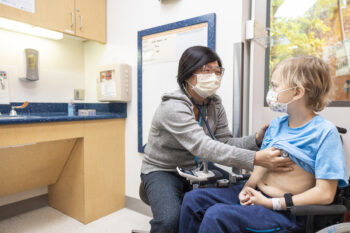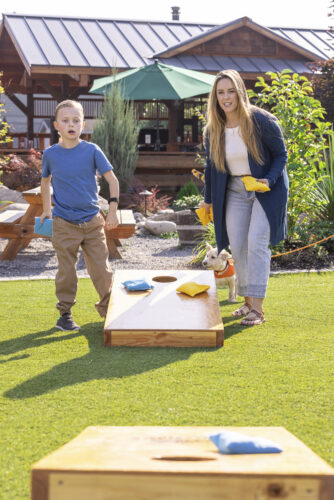
For American Heart Month, Seattle Children’s providers share their tips for helping kids and teens build strong, healthy hearts.
Protect young athletes with pre-sport heart screenings
Generally, kids are safe to play sports and exercise without concern for cardiac events, but with all types of sports, it is important to do a physical with family history to identify those who might be at risk.
Dr. Jack Christian Salerno, Associate Chief, Division of Cardiology; Director, Electrophysiology and Pacing Services, said parents can help protect their young athletes from sudden cardiac arrest by learning about potential “red flags” before their kids begin competing in sports during the middle- and high-school years.
The American Heart Association recommends that kids and teens be screened against a 14-point checklist that includes a review of the athlete’s personal and family medical history, and a physical exam by a doctor.
The medical history review looks for risk factors like chest pain, elevated blood pressure and unexplained fainting, as well as any family history of heart disease.
“It’s important for student-athletes and their parents to work closely with their physicians to detect any potential risks before the season begins,” Dr. Salerno said. “A positive response to one or more items on the checklist could trigger further testing, including an electrocardiogram.”
Help kids eat a heart-healthy diet
The Seattle Children’s pediatric dietitian team says now is the time for parents to help their kids develop heart-healthy habits when it comes to food. Their heart-healthy nutrition tips include the following:
- Know your cholesterols. Only animal products, like meat, egg yolks, and dairy products, contain cholesterol. LDL, or low-density lipoprotein cholesterol, is known as “bad” cholesterol. High levels of LDL increase the risk of heart disease. HDL, or high-density lipoprotein cholesterol, is the good kind and can help protect against heart disease. Just remember, “Low you want low” and “high you want high.”
- Serve meals that have a protein source, grains, fruit, vegetables and dairy. Proteins include meat, poultry, fish, tofu, beans, eggs or nuts. Plant-based proteins like tofu, beans and nuts do not contain cholesterol and are great additions to your protein rotation. Have fruits and vegetables on hand for easy heart-healthy snack options. Cover about half of your plate with fruits and vegetables in a variety of colors.
- Choose whole grain breads, pasta, rice and cereals. Whole grain foods are a good source of fiber, which is a must-have for heart-healthy diets. Soluble fiber binds to LDL cholesterol and helps flush it out of the body.
- Create balanced snacks from multiple food groups. This can include things such as whole grain toast with nut butter and banana slices. Try to limit snacks like that contain hydrogenated oils, which are also known as trans fats. Check ingredient labels for hydrogenated oils and try to pick another option if possible.
- Fat is an important part of a heart healthy diet. Unsaturated fats, which are found in foods like fish, nuts, avocados and oils, are high in unsaturated fat, which can help increase your child’s HDL levels. Saturated fats are found in foods like meats, butter and full-fat dairy products. Saturated fats can increase LDL levels, so making small changes like experimenting with olive oil instead of butter on bread can support heart health.
- Include the whole family in food preparation and cooking. It can be challenging to find healthy meals when eating out, so make eating at restaurants and fast food an occasional special treat. Try visiting a farmer’s market or garden to learn more about where foods come from.

Encourage ‘active play every day’
“Anything that gets the heart rate up – even a little bit – is good for the heart!” said Dr. Mollie Grow, a pediatrician at Seattle Children’s and the daughter of a cardiologist.
“My motto for young children is ‘active play every day.’ Kids naturally love to play and we can teach them from a young age how to enjoy being active.” she shared. “Being active on a regular basis helps strengthen our hearts.”
Stronger hearts pump blood more efficiently, which can help lower blood pressure. Preschoolers need at least two hours of active play each day, whereas kids and teens should get at least one hour each day.
Dr. Grow offers five simple tips parents can use to help their kids develop a love of activity:
- Be your kid’s playmate. Kids are more active if they have people to be active with, so plan family activities like walking to the park, kicking a ball, bike riding, playing tag, or dancing. Put on some good music and move together with a spontaneous dance party. Dr. Grow recommends simple games, which are often the most fun.
- Get outdoors. Outdoor activity is a great way for kids to stay active. It’s also nourishing for our mental health to spend time in nature. Most kids don’t get enough outdoor playtime on a regular basis. Make it your goal to get outside once a day, and don’t let cold weather deter you. Dr. Grow suggests searching used clothing stores for rain suits and boots so the whole family can be comfortable outside.
- Add to your indoor repertoire. Create a list of go-to indoor activities like dancing or tossing a ball to keep kids engaged. Brainstorm with other parents or browse local parenting blogs and magazines for indoor play areas. For instance, many community centers offer open gyms and toddler play zones.
- Plan for it – and get the kids’ ideas. Set aside dedicated time for play in the evenings and on weekends when families are together. Get the kids’ input and let them pick the activity. Sign up for structured activities that your kids enjoy, like swim or karate lessons.
- Look for “activity opportunities.” Dr. Grow suggests building in “little bits of activity” throughout the day, whether it’s taking the stairs, walking the kids to school, or taking an evening walk to the grocery store rather than driving. “It’s so true that when it comes to activity, everything counts,” Dr. Grow said.
Talk to your kids and teens about the dangers of smoking and vaping
The health risks associated with tobacco – including heart disease – are well documented. Parents and caregivers should talk to their children about the dangers of smoking and vaping, explained Dr. Cora Breuner, Attending Physician, Adolescent Medicine at Seattle Children’s.
According to Dr. Breuner, one concerning trend is the increased use of vape products including vapes, vape pens, e- cigarettes and e-cigars. Vaping is dangerous, not only due to exposure to nicotine, a carcinogen, but also because of the products in the pens, which can include diacetyl, which has links to lung disease, heavy metals such as nickel, tin, and lead and other volatile organic compounds.
“Teens may perceive this as a healthier, tastier and more social way to ingest tobacco,” Dr. Breuner said. “But vapes still deliver the same addictive nicotine and toxins as cigarettes, and there is no regulation or quality control of what is actually being smoked.”
In addition to increased risks for cancer and other diseases, the Centers for Disease Control and Prevention (CDC) warns that vape smokers may take in higher concentrations of the toxins found in cigarette smoke – toxins that are known to clog arteries and cause heart disease. Hookah users may also not be aware of how concentrated nicotine and other toxins may be in the pipes.
If you know or suspect your teen is smoking or vaping, Dr. Breuner recommends beginning by asking questions, listening, and sharing basic facts about tobacco and vaping. She also encourages parents to set family rules about drug and alcohol use, and make sure tweens and teens are aware of expectations and consequences.
“It’s essential for parents and caregivers keep lines of communication open with their children throughout the adolescent years,” shared Dr. Breuner . “Parents and caregivers are the primary influence on teenagers’ behavior, even if it doesn’t seem that way. They can model healthy habits their kids can use in their own lives.”

